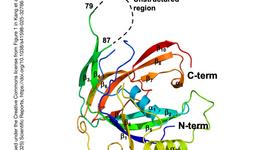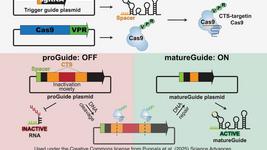CMN Weekly (7 March 2025) - Your Weekly CRISPR Medicine News
By: Gorm Palmgren - Mar. 7, 2025
Top picks
- American researchers have shown that incorporating nitro-oleic acid (NOA) into plasmid DNA-loaded lipid nanoparticles (pDNA-LNPs) mitigates acute inflammation in mice by inhibiting the cGAS–STING pathway. This modification enabled prolonged transgene expression, 11.5 times greater than mRNA-LNPs at day 32. Further optimisation increased in vitro expression 50-fold. NOA-pDNA-LNPs offer a safer, more efficient platform for long-term, promoter-controlled gene expression in genetic medicine.
- Prime editing of the obesogenic FTOrs9939609-A allele in human embryonic stem cells has revealed its role in accelerating skeletal muscle development and insulin resistance. The allele increased expression of the fat mass and obesity-associated (FTO) gene, enhancing H19/IGF2 signalling via m6A demethylation. While promoting early growth, this overstimulation led to insulin resistance upon ageing or high-fat diet exposure. These findings clarify FTO's paradoxical link to both leanness and obesity.
Research
- CRISPR-Cas9 knockout of diacylglycerol kinase (DGK) α and ζ has been shown to enhance TAG-72 CAR-T cell efficacy against ovarian cancer. The modification improved persistence and anti-tumor activity without affecting viability. DGKα/ζ KO CAR-T cells eradicated tumours in vivo for up to 100 days, whereas controls showed relapse by day 40. This strategy strengthens CAR-T responses in solid tumours, overcoming immune suppression and improving long-term tumour control.
- An American study has explored how enlarging the recognition (REC) domain of CRISPR-Cas9 can improve adenine base editing accuracy. The researchers at Tufts University engineered a "giant" SpCas9 (GS-Cas9) by expanding the REC domain, demonstrating reduced off-target effects and improved precision of the adenine base editor ABE8e.
- Researchers found that Cas9 interacts with ribosomes in mammalian cells, sequestering it in the cytoplasm. This interaction is RNA-mediated and reduces Cas9 nuclear entry. Increasing the number of nuclear localisation signals (NLSs) or cytoplasmic guide RNA levels can help overcome ribosomal binding, improving CRISPR-Cas9 nuclear localisation and genome-editing efficiency.
Industry
- Verve Therapeutics has announced full-year 2024 financial results with a net loss of $199 million and $524 million in cash.
- Intellia Therapeutics has announced full-year 2024 financial results with a net loss of $129 million and $862 million in cash.
- Iovance Biotherapeutics has announced full-year 2024 financial results with a net loss of $372 million and approximately $422 million in cash.
- Prime Medicine has announced full-year 2024 financial results with a net loss of $196 million and $205 million in cash.
- Fate Therapeutics has announced full-year 2024 financial results with a net loss of $186 million and $307 million in cash.
- Editas Medicine has announced full-year 2024 financial results with a net loss of $237 million and $270 million in cash.
- Beam Therapeutics has announced full-year 2024 financial results with a net loss of $377 million and $851 million in cash.
Clinical
- Korro Bio has begun dosing in its REWRITE study evaluating KRRO-110, an RNA-editing therapy for Alpha-1 Antitrypsin Deficiency (AATD). KRRO-110 uses endogenous ADAR enzymes to correct a SERPINA1 mutation, restoring functional AAT protein. The trial will assess safety, pharmacokinetics, and pharmacodynamics in up to 64 participants. Interim data from single-dose cohorts is expected in late 2025, with study completion anticipated in 2026.
Delivery
- Peptide-enabled ribonucleoprotein delivery for CRISPR engineering (PERC) is a new method that enables efficient CRISPR ribonucleoprotein delivery into primary human cells using a single amphiphilic peptide. It supports gene knockout, transgene knock-in, and base editing with high efficiency (>90%) in T cells and HSPCs. Unlike electroporation, PERC is hardware-free, minimally disruptive, and allows multiple treatments.
Screening
- CRISPR-Cas knockout screens often miss context-essential genes due to model variability. PRODE, a computational framework integrating gene effects with protein interactions, refines essentiality assessments. It improves recovery of missed essential genes in shRNA screens and prioritises context-essential hits in CRISPR-KO data. In Her2+ breast cancer, PRODE identifies oxidative phosphorylation genes as vulnerabilities, suggesting new therapeutic targets.
Detection
- A CRISPR-based RT-PCR assay has improved the diagnosis of the life-threatening fungal disease Pneumocystis jirovecii pneumonia (PCP) by enhancing sensitivity and specificity in non-invasive samples. In infants, oropharyngeal swab detection outperformed RT-qPCR (96.3% vs. 66.7% sensitivity). In adults, serum CRISPR assays were far superior (93.3% vs. 26.7% sensitivity).
- Researchers in China have presented an updated version of the SCas12a assay, which combines Cas12a with a split crRNA comprising a 20-nt scaffold RNA and a variable 20-nt spacer RNA. The new SCas12aV2 system enhances CRISPR-Cas12a-based RNA detection by reducing steric hindrance, enabling precise, amplification-free sensing of structured RNAs. Optimised scaffold RNA and hybrid activators improve sensitivity, achieving a 246 aM detection limit and accurately identifying SNPs, viable bacteria, and SARS-CoV-2 in clinical samples.
- Researchers in China have developed a modular microfluidic sensor integrating CRISPR-Cas13a and electrochemiluminescence (ECL) for rapid RNA-based pathogen detection. The system streamlines nucleic acid extraction and distribution, achieving detection in 30 minutes with a 0.372 fM sensitivity for E. coli 16S rRNA. It enables multiplexed detection, including real-time monitoring of bacterial growth in mixed cultures.
- A multiplex-gRNA-assisted CRISPR-Cas12a biosensor (MgCPA) enables amplification-free, quantitative detection of malathion using a glucometer. The system activates Cas12a's trans-cleavage upon malathion binding, releasing glucose signals for detection. With a sensitivity of 300 fM, it offers high selectivity, reproducibility, and stability, demonstrating practical use in food safety monitoring across various produce samples.
Reviews
- CRISPR integrated biosensors: A new paradigm for cancer detection. This review explores CRISPR-based biosensors for cancer diagnostics, highlighting their precision, sensitivity, and cost-effectiveness over conventional methods, with a focus on detecting lung, liver, colorectal, prostate, and cervical cancers.
- Application and development of CRISPR-Cas12a methods for the molecular diagnosis of cancer: A review. This review systematically explores the development, key technologies, and applications of CRISPR-Cas12a-based molecular diagnostics in cancer detection, highlighting its potential for clinical implementation.
To get more CRISPR Medicine News delivered to your inbox, sign up to the free weekly CMN Newsletter here.
Tags
ArticleMissing linksNewsCMN WeeklyBeam Therapeutics Inc.Editas Medicine, Inc.Fate Therapeutics, Inc.Intellia Therapeutics, Inc.Iovance BiotherapeuticsKorro BioPrime Medicine
CLINICAL TRIALS
IND Enabling
Phase I
Phase II
Phase III
Gastric Cancer and Colorectal Cancer, CRC, (NCT07166263)
Sponsors:
Base Therapeutics (Shanghai) Co., Ltd.
Sponsors:
Base Therapeutics (Shanghai) Co., Ltd.
IND Enabling
Phase I
Phase II
Phase III
Relapsed or Refractory Acute Myeloid Leukemia, AML, (NCT06541444)
Sponsors:
Base Therapeutics (Shanghai) Co., Ltd.
Sponsors:
Base Therapeutics (Shanghai) Co., Ltd.
IND Enabling
Phase I
Phase II
Phase III







